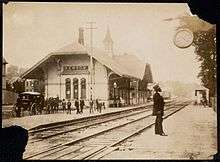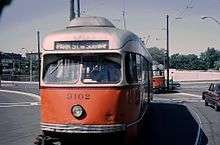Newton Corner (MBTA station)
NEWTON CORNER | |||||||||||||||||||||
|---|---|---|---|---|---|---|---|---|---|---|---|---|---|---|---|---|---|---|---|---|---|
 1880s-built Newton Corner depot on an early color postcard | |||||||||||||||||||||
| Coordinates | 42°21′27″N 71°11′04″W / 42.35756°N 71.18441°WCoordinates: 42°21′27″N 71°11′04″W / 42.35756°N 71.18441°W | ||||||||||||||||||||
| Owned by | Massachusetts Bay Transportation Authority | ||||||||||||||||||||
| Line(s) | |||||||||||||||||||||
| Tracks |
2 (Green Line) 4 (commuter rail) | ||||||||||||||||||||
| Connections |
| ||||||||||||||||||||
| History | |||||||||||||||||||||
| Opened |
c. 1834 (commuter rail) May 21, 1898 (Green Line) | ||||||||||||||||||||
| Closed |
April 1959 (commuter rail)[1] June 21, 1969 (Green Line)[2] | ||||||||||||||||||||
| Services | |||||||||||||||||||||
| |||||||||||||||||||||
Newton Corner is a former streetcar and passenger rail station in the Newton Corner neighborhood of Newton, Massachusetts, located near where Washington Street crosses the Massachusetts Turnpike. The Newton Corner station, known simply as Newton for much of its lifetime, served commuters on the Worcester Line (run by the New York Central Railroad and its predecessors) from 1834 to 1959. The trolley stop, located on the surface streets, served a number of routes beginning in 1898, including the Green Line "A" Branch until 1969.[3]
Newton Corner is now a stop and transfer point for a number of bus routes including high-frequency express routes to downtown Boston as well as local routes.
History
Railroad station

The Boston and Worcester Railroad opened the segment from downtown Boston to West Newton on April 7, 1834, with a station called Newton Corner opening then or soon after in the Angier's Corner neighborhood.[4][5] The station was located on the south side of the tracks west of Centre Street.[6][7] A second track was added in 1839, and in 1843 the railroad began offering season fares for around $60, making it one of the first commuter rail systems.[4] Newton Corner was among the most popular stations, with ridership of 26,000 in 1866.[8]
A village petition around 1870 resulted in the station being renamed as simply Newton.[5][8] Third and fourth tracks through the station were built in 1884.[1] Around this time, a new station building was built in the Richardsonian Romanesque style. The Boston & Worcester became part of the Boston and Albany Railroad in 1867, which itself was leased by the New York Central Railroad in 1900.[4]
Trolley station

The first trolleys in Allston-Brighton had been a branch off the Cambridge Horse Railroad to Oak Square, and ran to Cambridge rather than downtown Boston. On June 13, 1896, trackage on Commonwealth Avenue (part of the future "B" Branch) and Brighton Avenue opened as a direct electrified route to downtown; at the same time, the line was extended to just short of Newton Corner.[3]
The line begun running to Park Street in the new Tremont Street Subway on November 8, 1897. On May 21, 1898, the line was extended to Nonantum Square at Newton Corner, where it met lines running from Cambridge via Watertown.[3] On December 9, 1912, the transfer point was changed from Nonantum Square to Watertown Yard.[3] This completed the Watertown Line from Park Street to Watertown Yard - its route for the next half-century.
Closure
Both stations changed greatly when the Massachusetts Turnpike was extended from Route 128 in Weston to I-93 in downtown Boston. The highway occupied a significant portion of the right-of-way, dropping the Worcester Line from 4 to 2 tracks from Back Bay to Riverside. All local stops from Newton east were discontinued in April 1959; Newtonville, West Newton and Auburndale lost their depot buildings to construction but retained limited service.[1] This marked the end of service on the Worcester Line to Newton Corner; it has not been a commuter rail stop during the MBTA era.
In 1964, the exit 17 rotary was constructed at Newton Corner. Expecting little traffic at the intersection, the trolley tracks were placed in a counterflow lane, while the platforms were moved to the north side of the rotary in a dedicated median. However, the rotary proved to be busy and congested, resulting in frequent delays and crashes with the trolleys.
In 1967, the #69 trolley was renamed as the Green Line "A" Branch. After a series of temporary bustitutions during the 1960s, the "A" Branch was again "temporarily" substituted on June 21, 1969. However, the replacement #57 bus became permanent and the trolleys never returned.[2][3] The trackage was intact for non-revenue moves to Watertown Carhouse until 1994, but except for rare fan trips Newton Corner has not seen rail passengers since 1969.
Bus connections
Although no longer served by rail transport, Newton Corner is a major interchange for MBTA bus routes including the rail-replacement 57 and eight express buses. During morning rush hour, the eight express routes and two local routes combine such that over 60 buses traverse the rotary hourly, making Newton Corner one of the busiest MBTA bus stops.[9]
There are two bus stops on the rotary itself, with a large brick bench and shelter (more prominent than standard MBTA bus stops) on the southern (eastbound) side of the rotary and two standard shelters on the northern (westbound) part. Six routes stop at these locations:
- 52 Dedham Mall or Charles River Loop - Watertown Yard via Oak Hill & Newton Center
- 57 Watertown Yard - Kenmore Station via Newton Corner & Brighton Center
- 502 Watertown Yard - Copley Square (St. James Avenue at Dartmouth St.) via Newton Corner & Massachusetts Turnpike
- 504 Watertown/Newton Corner - Downtown via Massachusetts Turnpike
- 553 Roberts - Downtown Boston via Newton Corner & Central Square, Waltham
- 554 Waverly Square - Downtown Boston
- 556 Waltham Highlands - Downtown Boston via Newton Corner & Central Square, Waltham & Newtonville
- 558 Riverside - Downtown Boston via Newton Corner & Turnpike
The 553, 554, 556, and 558 each loop one-and-one-half times around the rotary in order to stop at both the south and north bus stops on each run in order to serve passengers who do not wish to cross the fast-moving rotary traffic on foot. Similarly, outbound 502 and 504 buses loop completely around the rotary before proceeding to Watertown.[9] The 52 and 57, which make local stops on both sides of the rotary, do not make these extra loops.
Two additional express routes pass through the rotary but instead use separate stops (shared with the 57) just to the south on Park Street:
- 501 Brighton Center - Downtown via Oak Square & Massachusetts Turnpike
- 503 Brighton Center - Copley Square via Oak Square & Massachusetts Turnpike
When proposals to reactivate the "A" Branch were considered in the 1970s and 1980s, a likely possibility was that the trolleys would only return as far as Oak Square, with trolleybuses filling the gap between Watertown and Oak Square. The City of Newton did not approve of overhead lines, however, and the proposals never came to fruition. However, a limited version of the proposal was considered wherein the 71 trolleybus would be extended from Watertown to Newton Corner. In the 2004 Program for Mass Transportation, the $1.5 million project was estimated to add 600 new daily transit riders but was given low priority compared to other bus expansion projects.[10]
References
- 1 2 3 Humphrey, Thomas J. & Clark, Norton D. (1985). Boston's Commuter Rail: The First 150 Years. Boston Street Railway Association. pp. 21–22. ISBN 9780685412947.
- 1 2 Belcher, Jonathan (27 June 2015). "Changes to Transit Service in the MBTA district 1964-2015" (PDF). NETransit. Retrieved 17 November 2015.
- 1 2 3 4 5 Moore, Scott. "The Watertown Line". NETransit. Archived from the original on 3 February 2002. Retrieved 18 February 2013.
- 1 2 3 Karr, Ronald Dale (1995). The Rail Lines of Southern New England. Branch Line Press. pp. 279–280. ISBN 0942147022.
- 1 2 Fleishman, Thelma (1999). Images of America: Newton. Arcadia Publishing. p. 32. ISBN 9780738537740 – via Google Books.
- ↑ Woodward, E.F.; Ward, W.F. (April 1848). "Map of the Town of Newton".
- ↑ "First Ward Newton City". Atlas of Newton. J.B. Beers & Co. 1874 – via Ward Maps.
- 1 2 Hatch, Kathlyn; et al. (c. 1977). "Newton's 19th Century Architecture: Newton Corner and Nonantum". Newton Historical Commission and Newton Department of Planning and Development. p. 5. Retrieved 18 February 2013.
- 1 2 Alicia Wilson; Seth Asante & Efi Pagitsas (19 September 2006). "Memorandum Re: I-90 Interchange 17 (Newton Corner): Traffic Patterns and Operational and Safety Improvements". City of Newton. Retrieved 19 February 2013.
- ↑ Central Transportation Planning Staff (January 2004). "Chapter 5C: System Expansion" (PDF). Program for Mass Transportation. Boston Metropolitan Planning Organization. Archived from the original (PDF) on 20 February 2012. Retrieved 18 February 2013.
External links
| Wikimedia Commons has media related to Newton Corner (MBTA station). |